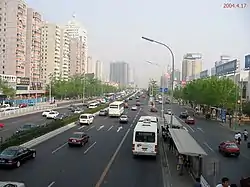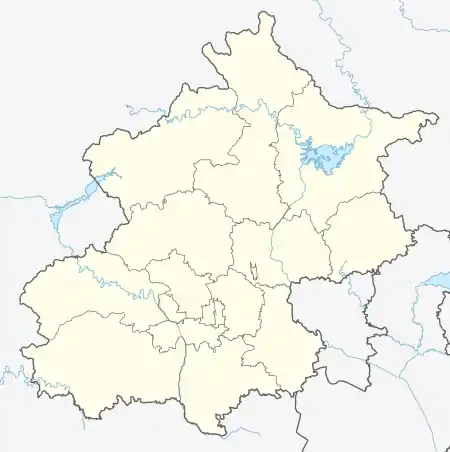Xiangheyuan Subdistrict
香河园街道 | |
|---|---|
 Jing'anzhuang within the subdistrict, 2004 | |
 Xiangheyuan Subdistrict | |
| Coordinates: 39°57′35″N 116°25′52″E / 39.95972°N 116.43111°E 39°57′35″N 116°25′52″E / 39.95972°N 116.43111°E | |
| Country | China |
| Municipality | Beijing |
| District | Chaoyang |
| Area | |
| • Total | 2.5 km2 (1.0 sq mi) |
| Population (2020) | |
| • Total | 43,002 |
| • Density | 17,000/km2 (45,000/sq mi) |
| Time zone | UTC+8 (China Standard) |
| Postal code | 100028 |
| Area code | 010 |
Xiangheyuan Subdistrict (Chinese: 香河园街道; pinyin: Xiānghéyuán Jiēdào) is a township-level division situated in Chaoyang District Beijing, China.[1] In 2020, it had a total population of 43,002.[2]
The subdistrict was named after Xiangheyuan (Chinese: 香河园; lit. 'Garden of Fragrant River') Road within it.
History
| Time | Status |
|---|---|
| Qing dynasty | Part of Daxing County, Shuntian Prefecture |
| 1925 | Part of East Suburban District |
| 1947 | Part of 8th Suburban District |
| 1949 | Part of 14th District, East Suburb |
| 1952 | Part of Taiyangong Township |
| 1957 | Incorporated into Zuojiazhuang Subdistrict except Xibahe Beili |
| 1959 | Part of Wuluju Subdistrict |
| 1968 | Part of Heping Street Subdistrict |
| 1977 | Part of Zuojiazhuang Subdistrict |
| 1987 | Separated from Zuojiazhuang Subdistrict and established as Xiangheyuan Subdistrict |
Administrative Division
At the end of 2021, there were nine communities within the subdistrict:[4]
| Administrative Division Code | Community Name in English | Community Name in Simplified Chinese |
|---|---|---|
| 110105006034 | Xibahe Nanli | 西坝河南里 |
| 110105006037 | Xibahe Xili | 西坝河西里 |
| 110105006038 | Xibahe Zhongli | 西坝河中里 |
| 110105006039 | Liufang Beili | 柳芳北里 |
| 110105006040 | Liufang Nanli | 柳芳南里 |
| 110105006041 | Guangximen Beilibei | 光熙门北里北 |
| 110105006042 | Guangximen Beilinan | 光熙门北里南 |
| 110105006043 | Xibahe Dongli | 西坝河东里 |
| 110105006044 | Guangxi Jiayuan | 光熙家园 |
See also
References
- ↑ "保定市-行政区划网" (in Chinese). xzqh.org. Archived from the original on March 29, 2012. Retrieved 3 January 2024.
- ↑ Zhong guo tong ji nian jian = China statistical yearbook. 2020(zong di 39 qi) 2020(No. 39). Guo jia tong ji ju, 国家统计局. (Di 1 ban ed.). Beijing: Zhong guo tong ji chu ban she. 2020. ISBN 978-7-5037-9225-0. OCLC 1262741013.
{{cite book}}: CS1 maint: others (link) - ↑ Zhong hua ren min gong he guo zheng qu da dian. Bei jing shi juan. Li li guo, Li wan jun, Wu shi min, 李立国., 李万钧., 吴世民. Bei jing: Zhong guo she hui chu ban she. 2013. ISBN 978-7-5087-4058-4. OCLC 910451741.
{{cite book}}: CS1 maint: others (link) - ↑ "2021年统计用区划代码和城乡划分代码". www.stats.gov.cn. Retrieved 2022-09-23.
This article is issued from Wikipedia. The text is licensed under Creative Commons - Attribution - Sharealike. Additional terms may apply for the media files.